Europe
 In what is one of the funniest displays of “wealth” the pineapple was once carried around as proof that the one carrying it was a first-class citizen. Now, I can’t say that I think the tradition made any sense, but in 18th century England, pineapples really were a status symbol. Their very cost set the apart as something only owned by the very rich. Like many of the upper-class citizens of that era, they liked to flaunt their wealth to those less fortunate. So, those rich enough to own a pineapple would carry them around to signify their personal wealth and high-class status. They also adorned everything from clothing to houseware with the tropical fruit.
In what is one of the funniest displays of “wealth” the pineapple was once carried around as proof that the one carrying it was a first-class citizen. Now, I can’t say that I think the tradition made any sense, but in 18th century England, pineapples really were a status symbol. Their very cost set the apart as something only owned by the very rich. Like many of the upper-class citizens of that era, they liked to flaunt their wealth to those less fortunate. So, those rich enough to own a pineapple would carry them around to signify their personal wealth and high-class status. They also adorned everything from clothing to houseware with the tropical fruit.
Pineapples were first imported from South America to Europe by Spanish explorers starting in the 16th century. Though native to South America, pineapples made their  way to the Caribbean Island of Guadeloupe. It was in Guadeloupe that Christopher Columbus first spotted their spiky crowns in 1493. He and his crew took the pineapples back to Spain, where everyone loved how sweet this new, exotic fruit tasted. Unfortunately, because they were a tropical fruit, the pineapples wouldn’t grow in Spain. The only pineapples they could get their hands on had to be imported from across the Atlantic. It was time consuming and expensive undertaking, and often resulted in rotten fruit. From Spain, they then came to England. It was in England that the pineapple became the most prestigious fruit of the 18th century. European sailors brought it home as a sign of successful expedition and evidence of their prosperity. It also became a decorative piece on upper-class dining tables. When a pineapple was seen decorating the dining table of a home, you knew that the family had traveled places and
way to the Caribbean Island of Guadeloupe. It was in Guadeloupe that Christopher Columbus first spotted their spiky crowns in 1493. He and his crew took the pineapples back to Spain, where everyone loved how sweet this new, exotic fruit tasted. Unfortunately, because they were a tropical fruit, the pineapples wouldn’t grow in Spain. The only pineapples they could get their hands on had to be imported from across the Atlantic. It was time consuming and expensive undertaking, and often resulted in rotten fruit. From Spain, they then came to England. It was in England that the pineapple became the most prestigious fruit of the 18th century. European sailors brought it home as a sign of successful expedition and evidence of their prosperity. It also became a decorative piece on upper-class dining tables. When a pineapple was seen decorating the dining table of a home, you knew that the family had traveled places and  were either explorers or merchants with money, to afford the exotic fruit.
were either explorers or merchants with money, to afford the exotic fruit.
Because of its new-found fame, the pineapple grew to be very expensive. In the American colonies in the 1700s, pineapples were no less special. They were imported from the Caribbean Islands, and the pineapples that arrived in America were very expensive. In fact, one pineapple could cost as much as $8000…in today’s dollars. While they may have been a symbol of wealth, if you ask me, carrying one around would not be a wise way to show that wealth. It wouldn’t take long for that coveted fruit to go bad, and they all you had was the memory of the money spent and thrown away.
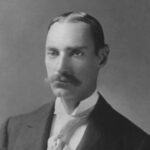
 John Jacob Astor IV was born on July 13, 1864 at his parents’ country estate of Ferncliff in Rhinebeck, New York. He was the youngest of five children and only son of William Backhouse Astor Jr, a businessman, collector, and racehorse breeder/owner, and Caroline Webster “Lina” Schermerhorn, a Dutch-American socialite. His four elder sisters were Emily, Helen, Charlotte, and Caroline (“Carrie”). John Astor IV was an American business magnate, real estate developer, investor, writer, lieutenant colonel in the Spanish–American War. He came from a long line of the very prominent Astor family.
John Jacob Astor IV was born on July 13, 1864 at his parents’ country estate of Ferncliff in Rhinebeck, New York. He was the youngest of five children and only son of William Backhouse Astor Jr, a businessman, collector, and racehorse breeder/owner, and Caroline Webster “Lina” Schermerhorn, a Dutch-American socialite. His four elder sisters were Emily, Helen, Charlotte, and Caroline (“Carrie”). John Astor IV was an American business magnate, real estate developer, investor, writer, lieutenant colonel in the Spanish–American War. He came from a long line of the very prominent Astor family.
Astor’s was an accomplished writer, having published “A Journey in Other Worlds” (1894), a science-fiction novel about life in the year 2000 on the planets Saturn and Jupiter. He was also an inventor. He patented several inventions, including a bicycle brake in 1898, a “vibratory disintegrator” used to produce gas from peat moss, and a pneumatic road-improver, and he helped develop a turbine engine. He was a great visionary, and his contributions to the world were amazing. 
Astor married socialite Ava Lowle Willing on February 17, 1891. The couple had two children, William Vincent Astor (November 15, 1891 – February 3, 1959), businessman and philanthropist, and Ava Alice Muriel Astor (July 7, 1902 – July 19, 1956). The couple divorced in November 1909. Astor IV remarried shortly thereafter, compounding the scandal of his divorce. At the age of 47, Astor married 18-year-old socialite Madeleine Talmage Force, the sister of real estate businesswoman and socialite Katherine Emmons Force. Astor and Force were married in his mother’s ballroom at Beechwood, the family’s Newport, Rhode Island, mansion. There was also much controversy over their 29-year age difference. His son Vincent despised Force, yet he served as best man at his father’s wedding. The couple took an extended honeymoon in Europe and Egypt to wait for the gossip to calm down. Among the few Americans who did not spurn him at this time was Margaret Brown, later fictionalized as The Unsinkable Molly Brown. She accompanied the Astors to Egypt and France. After receiving a call to return to the United States, Brown accompanied the couple back home aboard RMS Titanic.
Astor IV died in the sinking of the RMS Titanic during the early hours of April 15, 1912. Astor was the richest passenger aboard the RMS Titanic and was thought to be among the richest people in the world at that time. He was also a true gentleman, who would never have been on a lifeboat without knowing that all the women and children were on lifeboats. Astor IV had a net worth of roughly $87 million when he died, which would be 
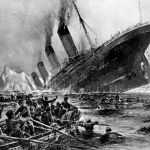 equivalent to $2.44 billion in 2021. Astor, like his predecessors also made millions in real estate. In 1897, Astor built the Astoria Hotel, “the world’s most luxurious hotel”, in New York City, adjoining the Waldorf Hotel owned by Astor’s cousin and rival, William. Later, the complex became known as the Waldorf-Astoria Hotel. The Waldorf-Astoria was the host location to the United States inquiries into the sinking of the RMS Titanic, on which Astor died.
equivalent to $2.44 billion in 2021. Astor, like his predecessors also made millions in real estate. In 1897, Astor built the Astoria Hotel, “the world’s most luxurious hotel”, in New York City, adjoining the Waldorf Hotel owned by Astor’s cousin and rival, William. Later, the complex became known as the Waldorf-Astoria Hotel. The Waldorf-Astoria was the host location to the United States inquiries into the sinking of the RMS Titanic, on which Astor died.

 Many people think that the Leaning Tower of Pisa was once straight, and then gradually began to lean, but that is not the case at all. Nevertheless, the lean became problematic over time. Construction on the Leaning Tower began on August 9, 1173. The plan was for the tower to house the bells of the vast cathedral of the Piazza dei Miracoli, which means the “Place of Miracles” in English. The city of Pisa at that time was a major trading power and one of the richest cities in the world. The bell tower was designed to be the most magnificent tower Europe had ever seen. Work progressed…until the tower was just over three stories tall, and then it abruptly stopped for reasons unknown. There has been speculation as to why the construction was stopped. Some people think it may have been because of economic or political strife, but the consensus seems to be that the engineers may have noticed that even then, the tower had begun to sink down into the ground on one side.
Many people think that the Leaning Tower of Pisa was once straight, and then gradually began to lean, but that is not the case at all. Nevertheless, the lean became problematic over time. Construction on the Leaning Tower began on August 9, 1173. The plan was for the tower to house the bells of the vast cathedral of the Piazza dei Miracoli, which means the “Place of Miracles” in English. The city of Pisa at that time was a major trading power and one of the richest cities in the world. The bell tower was designed to be the most magnificent tower Europe had ever seen. Work progressed…until the tower was just over three stories tall, and then it abruptly stopped for reasons unknown. There has been speculation as to why the construction was stopped. Some people think it may have been because of economic or political strife, but the consensus seems to be that the engineers may have noticed that even then, the tower had begun to sink down into the ground on one side.
The tower sat unfinished for 95 years, which allowed the building to settle, and the new chief engineer tried to figure out a way to compensate for the tower’s visible lean by making the new stories slightly taller on the short side. In theory, that may have seemed like a viable solution, but when you add weight without addressing the problem that is causing the building to sink, you are fighting against yourself. By 1278, when the workers had reached the top of the seventh story, they were forced to stop construction again, because they realized that the southward tilt was now nearly three feet…even with the adjustments they had tried to make to compensate.
The frustrated Italian government, rather at its wits end, announced on February 27, 1964, that it would be accepting suggestions on how to save the renowned Leaning Tower of Pisa from collapse. By this time, the top of the 180-foot tower was hanging an astonishing 17 feet south of the base, and to make matters worse, studies showed that the tilt was increasing by a fraction every year. That may not seem like so much, but like the “straw that broke the camel’s back,” no one knew Exactly when the point would come when the tower could not be saved. That also meant that the tower was unsafe to allow people to come in, or at least it was perceived to be eminently unsafe, and when the experts warned that the medieval building…one of Italy’s top tourist attractions, was in serious danger of collapse in an earthquake or storm, something had to be done.
The Italian government began to reach out in earnest for proposals to save the Leaning Tower, and proposals came from all over the world, but it was not until 1999 that successful restorative work began. In recent years, the cause of the lean was finally determined to be that the tower’s lean was caused by the remains of an ancient river estuary located under the building. That information told them that a completely safe resolution was unlikely, and that straightening the tower was completely out of reach in its current location.
In 1990, the Italian government closed the Leaning Tower’s doors to the public out of safety concerns and began considering more drastic proposals to save the tower. Then, in 1992, in an effort to temporarily stabilize the building, plastic-coated steel tendons were built around the tower up to the second story. In 1993, a concrete foundation was built around the tower, adding counterweights on the north side. The use of these weights lessened the tilt by nearly an inch, bringing new hope to the people. Still, it was an eyesore, and in 1995, the commission overseeing the restoration sought to replace the unsightly counterweights with underground cables. The strange method to do this was that engineers froze the ground with liquid nitrogen in preparation for the removal of the counterweights. Unfortunately, this actually caused a dramatic increase in the lean and the project was called off. Finally, in 1999, engineers began a process of soil extraction under the north side that within a few months was showing positive effects. The soil was removed at a very slow pace, no more than a gallon or two a day, and a massive cable harness held the tower to avoid any sudden destabilization. Finally, it seemed that progress was being made. Within six months, the tilt had been reduced 
 by over an inch, and by the end of 2000, nearly a foot. Relieved, the Italian government was able to reopen the tower to the public in December 2001, after a foot-and-a-half reduction had been achieved. While this will not stop the continuing tilt, it is expected that those 18 inches will give another 300 years of life to the Leaning Tower of Pisa…an amazing feat indeed. The tower will have to be carefully monitored to ensure the safety of those who visit it every year, but for now, disaster has been averted.
by over an inch, and by the end of 2000, nearly a foot. Relieved, the Italian government was able to reopen the tower to the public in December 2001, after a foot-and-a-half reduction had been achieved. While this will not stop the continuing tilt, it is expected that those 18 inches will give another 300 years of life to the Leaning Tower of Pisa…an amazing feat indeed. The tower will have to be carefully monitored to ensure the safety of those who visit it every year, but for now, disaster has been averted.
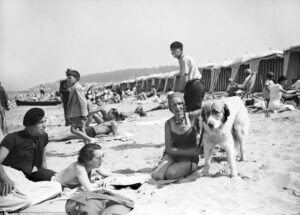
 Over the years, many people have collected postcards. Some like them for the scenic views, and some collect postcards that have been sent to them, saving them as mementos of family members who won’t always be with us. I have picked up lots of postcards for my sister, Cheryl Masterson, who has a collection. While this is a cool way to get great pictures of amazing places, postcards were once used as…intel.
Over the years, many people have collected postcards. Some like them for the scenic views, and some collect postcards that have been sent to them, saving them as mementos of family members who won’t always be with us. I have picked up lots of postcards for my sister, Cheryl Masterson, who has a collection. While this is a cool way to get great pictures of amazing places, postcards were once used as…intel.
Starting in 1942, as the BBC, as part of their planning of the D-Day attack, issued a public appeal for postcards and photographs of mainland Europe’s coast, from Norway to the Pyrenees. The British people were eager to help and began sending in postcards and pictures from their trips to France. Other families began searching through boxes of family photos, searching for anything that might show the beaches. Photos of kids building  sandcastles, and people lounging on the beach flooded the BBC offices. While it all seemed like a fun project, the people had no idea that their family photographs would prove very instrumental in the D-Day landings. Within 36 hours, over 30,000 packs of pictures of the French coast arrived at the BBC offices. Even more incredible was the fact that by 1944, 10 million holiday snaps and postcards, hotel brochures, letters and guidebooks had arrived by post. Once there, the postcards and photographs were sorted, and the best ones were pinned to a board in a top-secret planning room. Then the army bosses began to study every inch of the beaches and landing areas where the Normandy invasion would go on to take on June 6, 1944.
sandcastles, and people lounging on the beach flooded the BBC offices. While it all seemed like a fun project, the people had no idea that their family photographs would prove very instrumental in the D-Day landings. Within 36 hours, over 30,000 packs of pictures of the French coast arrived at the BBC offices. Even more incredible was the fact that by 1944, 10 million holiday snaps and postcards, hotel brochures, letters and guidebooks had arrived by post. Once there, the postcards and photographs were sorted, and the best ones were pinned to a board in a top-secret planning room. Then the army bosses began to study every inch of the beaches and landing areas where the Normandy invasion would go on to take on June 6, 1944.
The families who sent in their family photographs and postcards, had no idea what would come of their contribution. They weren’t told why their pictures were needed, just that it was an important project. Looking at the photographs now, the innocent snaps almost bring a feeling of deep sadness. Nevertheless, the photographs and postcards were instrumental and extremely important to the war effort. After looking at all the 
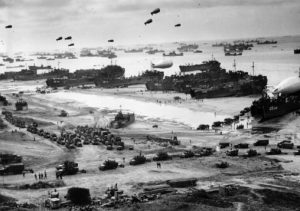 pictures, it was decided that the best place to carry out their plan was on the beaches at Normandy, France. Many of these postcards were used in briefings with officers, land craft operators and other infantry soldier to study and orient themselves based on their drop locations of the building and landmarks in these photos. Of course, the rest is history, and the operation to storm the beaches at Normandy was a great success.
pictures, it was decided that the best place to carry out their plan was on the beaches at Normandy, France. Many of these postcards were used in briefings with officers, land craft operators and other infantry soldier to study and orient themselves based on their drop locations of the building and landmarks in these photos. Of course, the rest is history, and the operation to storm the beaches at Normandy was a great success.

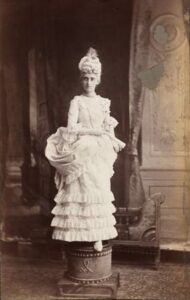 The Gilded Age, as we all know, was a time of great wealth. In fact, the rich people of that time literally had more money than they knew what to do with. Their solution was to spend it lavishly…building huge estates that stretched for miles, and home that were not only huge, but were lavishly decorated. The idea was to show the world that they had money and that they could do what they wanted. The thing is, you can only build so many houses, so what’s next. That said, they were always on the lookout for new and interesting ways to spend their money.
The Gilded Age, as we all know, was a time of great wealth. In fact, the rich people of that time literally had more money than they knew what to do with. Their solution was to spend it lavishly…building huge estates that stretched for miles, and home that were not only huge, but were lavishly decorated. The idea was to show the world that they had money and that they could do what they wanted. The thing is, you can only build so many houses, so what’s next. That said, they were always on the lookout for new and interesting ways to spend their money.
One of the “new and interesting things” they came up with were costume balls and theme parties. In fact, these were a special favorite. While this seems like an innocent and fairly inexpensive thing to do, the items these people purchased for their costume were definitely not inexpensive. They were a prime way to not only display wealth, but also to make a show of great spending on items that would be used for just one occasion and then tossed out or closeted away. Some of these items were quite expensive, and their owner couldn’t possibly be seen using it again, nor would these people buy something from someone else, because they didn’t want to use a hand-me-down item.
On March 26, 1883, one of the most famous balls of the age was held. It was an extremely elaborate costume ball to mark the housewarming of Cornelius and Alva Vanderbilt’s New York townhouse, which was built in the design of a French chateau. The thing is that while these people were all about wealth, they were a bit “snobby” about it, meaning that there was “old money” and there was “new money.” At this particular party, there was a bit of a problem, because the Vanderbilts were “new money” and not yet established in New York society. For Alva Vanderbilt, whose name we all know, this was humiliating. She thought her money should be as accepted as anyone else’s. To prove her family’s worth and that her money was as good as anyone else’s, she planned the party of all parties and even invited the media in to tour the new house and view the fancy party decor. Then to add insult to injury, she purposely did not send out an invitation to certain “old money” families. In the end, the Grande Dame of New York society, Mrs. Astor (who had a daughter who desperately wanted an invitation), was compelled to drop off her calling card at the Vanderbilt house. That card had great significance, because it signified that the Vanderbilts had at last “arrived” in society. Alva’s plan worked and she was delighted. So was Mrs. Astor’s daughter. Mrs. Astor, however, felt a little bit used. She was forced to accept 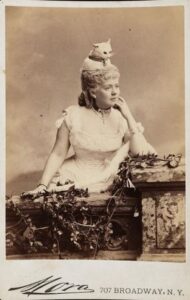
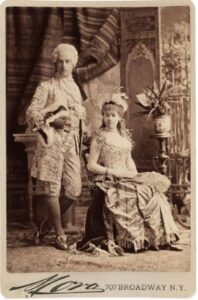 the Vanderbilts so her daughter would not be left out…whether she really accepted them in her heart, or not.
the Vanderbilts so her daughter would not be left out…whether she really accepted them in her heart, or not.
“New money” or “old money” aside, the party really was fantastic. Everyone went all out. Custom-made costumes, as well as costumes imported from Europe, featuring characters real and mythological from throughout European history. Alva had the Vanderbilt house decorated in silver and gold finery, with an abundance of colorful flowers on every floor. One floor was transformed into a tropical garden, and rooms throughout were lit by Japanese lanterns. Whether she planned it this way or not, in a smart move…for the sake of history…Alva hired professional photographers for the event. So, many of the photos taken that night have survived to prove that the ball really took place.
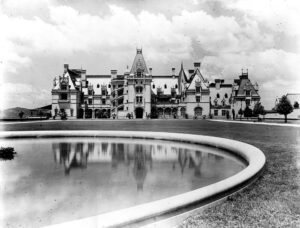
 During what became known as the Gilded Age in United States history, extending roughly from 1870 to 1900, the economy grew so rapidly that the wages of Americans, especially in the Northern and Western United States actually surpassed the wages in Europe, especially for skilled workers. Still, increased industrialization demanded an increased unskilled labor force too, so the there was an influx of millions of European immigrants looking for a better life, to fill the need for workers. Basically, the Gilded years were years of overwhelming extravagance.
During what became known as the Gilded Age in United States history, extending roughly from 1870 to 1900, the economy grew so rapidly that the wages of Americans, especially in the Northern and Western United States actually surpassed the wages in Europe, especially for skilled workers. Still, increased industrialization demanded an increased unskilled labor force too, so the there was an influx of millions of European immigrants looking for a better life, to fill the need for workers. Basically, the Gilded years were years of overwhelming extravagance.
While many of the estates of the Gilded Age were in the Eastern United States, not all the great estates were in places like New York City or Newport, Rhode Island. Some of the very wealthy apparently didn’t really like the Northern winter climates, so they chose to build their estates in areas of the South. One of the greatest of these southern estates was the Biltmore Estate near Asheville, North Carolina, The estate was built by George Washington Vanderbilt II between 1889 and 1896, and it is enormous!! The estate covers nearly 11 miles. Of course, the real difference between what we would consider a mansion, and the Gilded Era estates is the fact that the grounds are as extravagant as the homes. The main house of the Biltmore Estate has nearly 200,000 square feet!! Most of us consider a nice sized house to be 2,000 to 3,000 square feet, so 200,000 square feet, for me at least, is beyond what I can even imagine in a house. The construction was a huge undertaking, that literally took building an entire working village near the site to house the workers, manufacturers, and supplies. A three-mile railroad spur was even built just to transport building supplies to the construction site. More than 1,000 workers were hired to build the huge house.
The Biltmore remains in the ownership of the Vanderbilt family, with at least one member of the family living there until 1956, at which point it was operated as a historic museum. It is the largest privately owned home in the United States. To help with the high cost of modern maintenance and expenses, the house and grounds are 
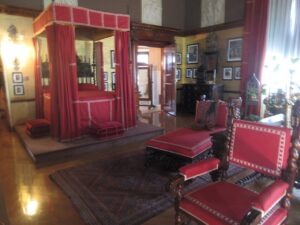 open to the public, for a price, and a number of ticketed events are held on the site throughout the year. At the request of the City of Asheville, which hoped to revitalize the area with tourism, and in an attempt to bolster the estate’s finances during the Great Depression, Cornelia and her husband opened Biltmore to the public in March 1930 at the request of the City of Asheville.
open to the public, for a price, and a number of ticketed events are held on the site throughout the year. At the request of the City of Asheville, which hoped to revitalize the area with tourism, and in an attempt to bolster the estate’s finances during the Great Depression, Cornelia and her husband opened Biltmore to the public in March 1930 at the request of the City of Asheville.

 My favorite part of war history, if a person should have a favorite part, would be World War II. It was the war my dad, Allen Spencer fought in, and maybe that is why I am so interested in it and in the B-17 Flying Fortress, from which he fought and returned home. The men and women who fought in World War II are called the Greatest Generation, and maybe because my dad was a part of that, I am partial to that part of history. I find it a bit strange that while the Vietnam Memorial Fund, Inc (VVMF) was incorporated as a non-profit organization to establish a memorial to veterans of the Vietnam War, on April 27, 1979, four years after the Fall of Saigon, but the World War II Memorial didn’t open until April 29, 2004, in Washington DC. Of course, I think it was cool that it opened on my birthday, but it really was a long overdue recognition for the 16 million US men and women who served in the war. The memorial is located on 7.4 acres on the former site of the Rainbow Pool at the National Mall between the Washington Monument and the Lincoln Memorial. The Capitol dome can be seen to the east, and Arlington Cemetery is just across the Potomac River to the west. It really is a beautiful setting and shows the proper honor to these men and women of the Greatest Generation.
My favorite part of war history, if a person should have a favorite part, would be World War II. It was the war my dad, Allen Spencer fought in, and maybe that is why I am so interested in it and in the B-17 Flying Fortress, from which he fought and returned home. The men and women who fought in World War II are called the Greatest Generation, and maybe because my dad was a part of that, I am partial to that part of history. I find it a bit strange that while the Vietnam Memorial Fund, Inc (VVMF) was incorporated as a non-profit organization to establish a memorial to veterans of the Vietnam War, on April 27, 1979, four years after the Fall of Saigon, but the World War II Memorial didn’t open until April 29, 2004, in Washington DC. Of course, I think it was cool that it opened on my birthday, but it really was a long overdue recognition for the 16 million US men and women who served in the war. The memorial is located on 7.4 acres on the former site of the Rainbow Pool at the National Mall between the Washington Monument and the Lincoln Memorial. The Capitol dome can be seen to the east, and Arlington Cemetery is just across the Potomac River to the west. It really is a beautiful setting and shows the proper honor to these men and women of the Greatest Generation.
The 16 million men and women who served in the armed forces of the US are honored at the World War II Memorial, as well as the more than 400,000 who died, and all who supported the war effort from home. The memorial was built using granite and bronze. It features fountains between arches to symbolize hostilities in Europe and the Far East. The arches are bordered by semicircles of pillars, one each for the states, territories, and the District of Columbia. Beyond the pool is a curved wall of 4,000 gold stars, one for every 100 Americans killed in the war. It also features an Announcement Stone that states that the memorial is to honor those  “Americans who took up the struggle during the Second World War and made the sacrifices to perpetuate the gift our forefathers entrusted to us: A nation conceived in liberty and justice.”
“Americans who took up the struggle during the Second World War and made the sacrifices to perpetuate the gift our forefathers entrusted to us: A nation conceived in liberty and justice.”
The project was funded with more than $164 million dollars in private donations, and an additional $16 million donated by the federal government. Former Kansas Senator Bob Dole, who was severely wounded in the war, and actor Tom Hanks were among its most vocal supporters. The really sad part is that only a fraction of the 16 million Americans who actually served in the would ever see it…my dad included. While he was alive in 2004, that was not a trip he got to take before his passing in 2007. Four million World War II veterans were still living at the time the memorial was finally opened, but more than 1,100 dying every day, according to government records. I find that to be so sad.
Roger Durbin of Berkey, Ohio, who served under General George S Patton, inspired the memorial. Durbin was at a fish fry near Toledo in February 1987, when he asked US Representative Marcy Kaptur why there was no memorial on the Mall to honor World War II veterans. It was a question that should have been asked and answered long ago. Nevertheless, Kaptur, an Ohio Democrat, introduced legislation to build one, starting a process that would stumble along through 17 years of legislative, legal, and artistic entanglements. Durbin died of pancreatic cancer in 2000, without ever actually seeing his hard work come to fruition. While he didn’t live to see his project come to life, I and so many other children of World War II veterans and lost loved ones, will be forever thankful to him for finally making sure our loved ones were properly honored. The monument was formally dedicated May 29, 2004, by US President George W Bush, but I am pleased that it actually opened on 
 my birthday in 2004. My birthday, because it was just two days after my dad’s birthday, has always been a special time that we shared. Of course, I was due and supposed to arrive on Dad’s birthday, but I’ve always said I was a little stubborn, so I held out. Nevertheless, we usually celebrated our days together, so I feel like his memorial opening on my birthday was really very cool.
my birthday in 2004. My birthday, because it was just two days after my dad’s birthday, has always been a special time that we shared. Of course, I was due and supposed to arrive on Dad’s birthday, but I’ve always said I was a little stubborn, so I held out. Nevertheless, we usually celebrated our days together, so I feel like his memorial opening on my birthday was really very cool.
 There are all kinds of records, but some are just stranger than others. Switzerland actually holds a strange record…for attacking its neighbor, Liechtenstein. This is particularly odd in that Switzerland is a neutral nation…very opposed to war!! In fact, Switzerland is the longest standing neutral nation in the world and has not taken part in a “war” since 1505. Its official stance of non-involvement had been decided during The Congress of Vienna in 1815, in which major European leaders met to discuss the nature of Europe after the defeat of Napoleon. Nevertheless, they do have an army.
There are all kinds of records, but some are just stranger than others. Switzerland actually holds a strange record…for attacking its neighbor, Liechtenstein. This is particularly odd in that Switzerland is a neutral nation…very opposed to war!! In fact, Switzerland is the longest standing neutral nation in the world and has not taken part in a “war” since 1505. Its official stance of non-involvement had been decided during The Congress of Vienna in 1815, in which major European leaders met to discuss the nature of Europe after the defeat of Napoleon. Nevertheless, they do have an army.
Diplomatic and economic relations between Switzerland and Liechtenstein have been good. In fact, you could say relations were very good, with Switzerland accepting the role of safeguarding the interests of its tiny next-door neighbor. Liechtenstein has an embassy in Bern, Switzerland, and Switzerland is accredited to Liechtenstein from its Federal Department of Foreign Affairs in Bern and maintains an honorary consulate in Vaduz, Liechtenstein. The two countries also share an open border, mostly along the Rhine, but also in the Rätikon range of the Alps, between the Fläscherberg and the Naafkopf.
With all that “good will” between the nations, you would never expect conflict, but apparently, Switzerland has  attacked Liechtenstein three times in 30 years. Of course, it was by mistake each time! How does that happen? Nevertheless, it did. The first time was probably the only “aggressive” accident of the bunch. On December 5, 1985, during an artillery exercise, the Swiss Army had launched munitions in the middle a winter storm. The wind took the munitions way off course, into the Bannwald Forest of Liechtenstein, and started a forest fire. No one was injured and the Liechtenstein government was very angry. Switzerland had to pay a heavy penalty for the environmental damage caused. The second attack took place on October 13, 1992. The Swiss Army received orders to set up an observation post in Treisenberg. They followed the orders and marched to Treisenberg. What they didn’t realize was that Treisenberg lies within the territory of Liechtenstein. They marched into Treisenberg with rifles and only later realized that they were in Liechtenstein. The last attack was on March 1, 2007. A group of Swiss Army infantry soldiers was in training when the weather took a bad turn. There was heavy rainfall, and the soldiers were not carrying any GPS or compass. Eventually, they ended up in Liechtenstein! Switzerland apologized to the Liechtenstein government for the intrusion, yet again.
attacked Liechtenstein three times in 30 years. Of course, it was by mistake each time! How does that happen? Nevertheless, it did. The first time was probably the only “aggressive” accident of the bunch. On December 5, 1985, during an artillery exercise, the Swiss Army had launched munitions in the middle a winter storm. The wind took the munitions way off course, into the Bannwald Forest of Liechtenstein, and started a forest fire. No one was injured and the Liechtenstein government was very angry. Switzerland had to pay a heavy penalty for the environmental damage caused. The second attack took place on October 13, 1992. The Swiss Army received orders to set up an observation post in Treisenberg. They followed the orders and marched to Treisenberg. What they didn’t realize was that Treisenberg lies within the territory of Liechtenstein. They marched into Treisenberg with rifles and only later realized that they were in Liechtenstein. The last attack was on March 1, 2007. A group of Swiss Army infantry soldiers was in training when the weather took a bad turn. There was heavy rainfall, and the soldiers were not carrying any GPS or compass. Eventually, they ended up in Liechtenstein! Switzerland apologized to the Liechtenstein government for the intrusion, yet again.
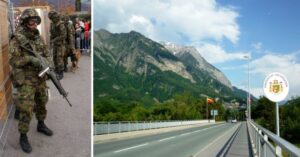
Thankfully these “accidental” attacks were not of a deadly nature. They were really more a “comedy of errors” than an attack. Thankfully, the people of Liechtenstein saw the “attacks” for what they were, and tended to care for their “intruders,” rather than fight back. Of course, that would have been difficult too, since Liechtenstein does not have an army of their own, and so depended on the “protection” of their neighbors…when they didn’t accidentally attack them.
 During World War II, there were hundreds of thousands, if not millions, of bombs dropped across Europe. There is no way to know where they were dropped, or if they actually exploded, or worse yet, if they are still lurking beneath the surface waiting to detonate. Princess Diana was a champion of a similar cause, but she was concerned about landmines…just as deadly, but a different deployment. Both concerns are real, and both situations are deadly. One German bomb specialist said that the problem will haunt Europe for centuries, saying, “There will still be bombs 200 years from now.”
During World War II, there were hundreds of thousands, if not millions, of bombs dropped across Europe. There is no way to know where they were dropped, or if they actually exploded, or worse yet, if they are still lurking beneath the surface waiting to detonate. Princess Diana was a champion of a similar cause, but she was concerned about landmines…just as deadly, but a different deployment. Both concerns are real, and both situations are deadly. One German bomb specialist said that the problem will haunt Europe for centuries, saying, “There will still be bombs 200 years from now.”
One such example is that of the German town of Limberg, whose residents woke up to a startling sight on the morning of June 23, 2019. A crater in a field as large as a house. The explosion was caused by a leftover bomb from World War II. Unexploded bombs really are a huge problem in Germany and other European countries, because these long-buried weapons periodically surface or spontaneously explode. No one knows when it might happen and the aftermath can be devastating. The explosion occurred in the central German town of Ahlbach, just north of Frankfurt. Residents reported hearing and feeling a large explosion in the early morning hours of Sunday the 23rd, but no one actually saw the explosion occur. During a follow-up the next day, they found a crater 33 feet wide and 14 feet deep in the middle of a barley field. It was determined that a decomposing bomb detonator for the explosion.

According to the BBC, “explosive ordnance demolition teams concluded that the explosive device was a 551 pound aerial bomb dropped by the Allies during World War II. The bomb was likely a M43, AN-M43, or AN-M64 500 pound general purpose bomb. General purpose bombs at terminal velocity will penetrate 3-4 building stories before detonating, so it’s not surprising this bomb buried itself so well.”
“The M65 was five feet long and 14 inches wide, and carried a payload of 280 pounds of TNT. The bomb casing, designed to produce fragment into lethal shrapnel, was .3 inches thick. An explosive ordnance disposal guidebook describes their purpose as to destroy ‘steel railway bridges, underground railways, sea craft such as light cruisers, concrete docks, medium sized buildings, etc.’”
During World War II, Germany operated several facilities in areas important to the war effort, including Limburg Field and an important railroad junction and marshaling yard. Allied bombs were dropped during the war, but often missed by miles. Falling at a high rate of speed, that morning’s bomb buried itself in the soft soil and  remained undetected for decades. Whoever cultivated the barley field obviously had no idea 280 pounds of highly unstable explosives lurked underneath, and thankfully no one was hurt
remained undetected for decades. Whoever cultivated the barley field obviously had no idea 280 pounds of highly unstable explosives lurked underneath, and thankfully no one was hurt
Seventy five years after the end of World War II, unexploded bombs are still a huge problem not only in Germany, but across all of Europe. The explosions don’t happen often, but when one explodes the results can be devastating. Governments are trying to find these bombs. Experts drill holes and look for bombs using magnetometers, searching for the signature of a bomb’s steel casing. Then they defuse or explode them harmlessly.
 World War II was finally winding down. Germany had surrendered. Japan was still a problem, but they were losing their strength too. Hitler committed suicide on April 30, and now it was over for Germany. I fact, it was time for celebration. So on May 8, 1945, both Great Britain and the United States celebrated Victory in Europe Day. The day would come to be known as V-E Day, and cities in both nations, as well as formerly occupied cities in Western Europe, put out flags and banners, rejoicing in the defeat of the oppressive Nazi war machine.
World War II was finally winding down. Germany had surrendered. Japan was still a problem, but they were losing their strength too. Hitler committed suicide on April 30, and now it was over for Germany. I fact, it was time for celebration. So on May 8, 1945, both Great Britain and the United States celebrated Victory in Europe Day. The day would come to be known as V-E Day, and cities in both nations, as well as formerly occupied cities in Western Europe, put out flags and banners, rejoicing in the defeat of the oppressive Nazi war machine.
That was 75 years ago today that the first V-E Day was celebrated. It is hard to believe that it was 75 years ago. I wasn’t born then, of course, but over the years of researching World War II, I almost feel like those events were just yesterday. Researching World War II bought the events…good, bad, and horrific to life for me. Our men and women, as well as those of the Allies were brave and noble people. They were fighting against two oppressive regimes, both of whom had murdered their own people and the people of the nations around them. The Nazi war machine had marched through Europe, terrorizing the people around them. The Luftwaffe planes bombed many cities, taking no concern for the civilians lost. Life meant nothing to them…except for their own. Hitler was greedy for power, and wanted to bring Nazism to the whole world. Thankfully they were stopped before they could complete their reign of terror.
German troops throughout Europe finally laid down their arms on May 8, 1945 in Prague. The Soviets had lost 8,000 soldiers by the time of the surrender, but the Germans had lost considerably more. They laid down their arms too, in Copenhagen and Oslo, at Karlshorst, near Berlin, in northern Latvia, and on the Channel Island of Sark. The German surrender was almost complete in that final cease-fire. More surrender documents were signed in Berlin and in eastern Germany.
The main concern of many German soldiers was to elude the grasp of Soviet forces, to keep from being taken prisoner. About 1 million Germans attempted a mass exodus to the West when the fighting in Czechoslovakia ended, but were stopped by the Russians and taken captive. The Russians captured approximately 2 million 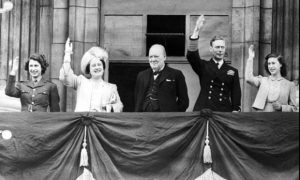 prisoners just before and after the German surrender. At the same time. 13,000 British soldiers were released and sent back to Great Britain. Of course, there were still pockets of confrontations into May 9th, and the Soviets lost an additional 600 soldiers in Silesia before the Germans finally surrendered. Those skirmishes pushed back the V-E Day celebration until the ninth in Moscow, with a radio broadcast salute from Stalin himself, “The age-long struggle of the Slav nations has ended in victory. Your courage has defeated the Nazis. The war is over.” It was a great day for all the people of the Allied nations, and the people of the world, with the exception of the Germans, Japanese, and the Axis nations. Good over evil.
prisoners just before and after the German surrender. At the same time. 13,000 British soldiers were released and sent back to Great Britain. Of course, there were still pockets of confrontations into May 9th, and the Soviets lost an additional 600 soldiers in Silesia before the Germans finally surrendered. Those skirmishes pushed back the V-E Day celebration until the ninth in Moscow, with a radio broadcast salute from Stalin himself, “The age-long struggle of the Slav nations has ended in victory. Your courage has defeated the Nazis. The war is over.” It was a great day for all the people of the Allied nations, and the people of the world, with the exception of the Germans, Japanese, and the Axis nations. Good over evil.

